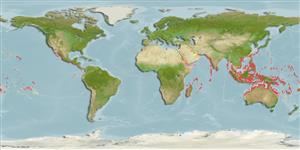Teleostei (teleosts) >
Ovalentaria/misc (Various families in series Ovalentaria) >
Plesiopidae (Roundheads) > Plesiopinae
Etymology: Plesiops: Greek, plesios = near + Greek, ops = appearance (Ref. 45335); coeruleolineatus: Species name refers to the blue lines present in the dorsal and anal fins.
More on author: Rüppell.
Environment: milieu / climate zone / depth range / distribution range
Ecology
Marine; reef-associated; depth range 1 - 23 m (Ref. 9710), usually 3 - 23 m (Ref. 27115). Tropical; 23°C - 27°C (Ref. 130632); 30°N - 30°S
Indo-Pacific: Red Sea and East Africa to Japan and Oceania.
Size / Weight / Age
Maturity: Lm ? range ? - ? cm
Max length : 10.0 cm TL male/unsexed; (Ref. 30874)
Dorsal spines (total): 10 - 12; Dorsal soft rays (total): 6 - 8; Anal spines: 3; Anal soft rays: 8. Color variable; body generally black or brown; 2 dark stripes behind eye; dorsal spines orange distally; bluish stripe along basal part of dorsal fin (Ref. 5473).
Body shape (shape guide): elongated; Cross section: compressed.
Adults are found under stone or corals in flood basins and lagoons (Ref. 9137). They are common but very secretive and usually found when turning rubble pieces in pools (Ref. 48635). They venture out in the open at night to feed on small crustaceans, fishes and gastropods (Ref. 37816). Eggs are guarded by the male parent (Ref. 205). Minimum depth reported from Ref. 30874.
Life cycle and mating behavior
Maturity | Reproduction | Spawning | Eggs | Fecundity | Larvae
Eggs are guarded by the male parent (Ref. 205).
Mooi, R.D., 1995. Revision, phylogeny, and discussion of biology and biogeography of the fish genus Plesiops (Perciformes: Plesiopsidae). Life Sci. Contrib. No. 159, 108 p. (Ref. 27772)
IUCN Red List Status (Ref. 130435: Version 2025-1)
Threat to humans
Harmless
Human uses
Fisheries: of no interest; aquarium: commercial
Tools
Special reports
Download XML
Internet sources
Estimates based on models
Preferred temperature (Ref.
123201): 24.8 - 29, mean 27.8 °C (based on 954 cells).
Phylogenetic diversity index (Ref.
82804): PD
50 = 0.5000 [Uniqueness, from 0.5 = low to 2.0 = high].
Bayesian length-weight: a=0.00468 (0.00175 - 0.01251), b=3.18 (2.95 - 3.41), in cm total length, based on LWR estimates for this (Sub)family-body shape (Ref.
93245).
Trophic level (Ref.
69278): 3.6 ±0.3 se; based on diet studies.
Resilience (Ref.
120179): High, minimum population doubling time less than 15 months (Preliminary K or Fecundity.).
Fishing Vulnerability (Ref.
59153): Low vulnerability (10 of 100).
🛈
Nutrients (Ref.
124155): Calcium = 134 [70, 220] mg/100g; Iron = 0.737 [0.439, 1.224] mg/100g; Protein = 18.5 [17.4, 19.5] %; Omega3 = 0.105 [0.060, 0.184] g/100g; Selenium = 22.9 [10.7, 46.9] μg/100g; VitaminA = 152 [50, 437] μg/100g; Zinc = 1.81 [1.20, 2.58] mg/100g (wet weight);
